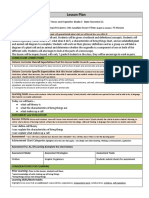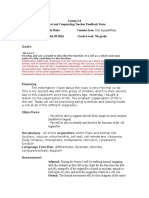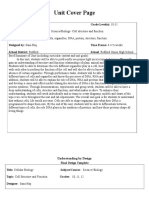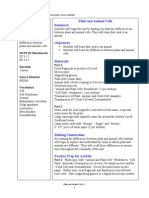Cell Model Project IB
Cell Model Project IB
Uploaded by
innovativiesCopyright:
Available Formats
Cell Model Project IB
Cell Model Project IB
Uploaded by
innovativiesCopyright
Available Formats
Share this document
Did you find this document useful?
Is this content inappropriate?
Copyright:
Available Formats
Cell Model Project IB
Cell Model Project IB
Uploaded by
innovativiesCopyright:
Available Formats
Cell Model Design Specifications
Problem: How do you effectively communicate the structures, processes, and systems that organize life on a cellular level in way that seventh graders can understand? In groups of 2, Students will construct neat and organized models of a plant and an animal cell. Options for model ideas are found on the back of this packet. Both the plant and animal cell must be created in the same style. So if you decide to make a plant cake, then the animal cell must also be in cake form. Students will design and label their cells and Identify the following organelles, give them a nickname, and their functions: Mitochondria Nucleus Ribosome Endoplasmic Reticulum Vacuole (plant and animal) Chloroplast (plant) Golgi Body Cell membrane and/or Cell Wall Cytoplasm
Basic research will be done together in class. Students will keep a design brief that documents their development of the model. Life Science Essential Knowledge All living things are composed of cells. a) Cells have structure and component parts (organelles) b) Plant and animal cells have similarities and differences; Living things show patterns of cellular organization. a) Life is organized into cells, tissues, organs, and systems. b) These systems perform essential life functions (respiration, removal of wastes, growth, reproduction, digestion, and cellular transport). Technology Essential Knowledge o A system can include processes as well as things. o Thinking about things as systems means looking for how every part relates to others. o Any system is usually connected to other systems, both internally and externally. o Models are often used to think about processes that happen on too small a scale to observe directly.
Assessment (Grades) Students will be assessed in both Science and Technology for this project. For Science, students projects will be judged for their achievement in Criteria B (Communication in Science) and C (Scientific Knowledge and Concepts). For Technology, students design folders will be judged for the achievement in Criteria A. Self Assessment 1. Have I researched, designed, planned, and created o a working model that communicates clearly and effectively o what the organelles looks like o what theyre called o what they do (function) o how they works (process) o how they relate to other organelles (internal system) o and the world beyond themselves (larger systems/ functions/ processes) 2. Did I consider and choose materials or technology that communicates using o color, texture, shape, contrast o movement o depth (3 dimensional) o scale (relative sizes)
Cell Project Ideas:
Be creative! Let your imagination fly!)- but dont spend a lot of money (or any money at all!), and check with me first if you have questions or ideas you want to explore. You must use the same basic plan/design for both cell types. Your models and your design folder are due on _________________________. Be sure to attach/turn in the rubric with your project. 1. Build a 3D non-edible (Styrofoam/clay/etc.) model of a plant and animal cell and all organelles. 2. Use a Christmas ornament and either: a. Paint it to look like an animal/plant cell and all organelles. b. If clear, you may fill the ornament to make a model of an animal/plant cell and all organelles. 3. Bake cookies/cupcakes/or a cake and decorate to look like an animal/plant cell and all organelles. If making cookies or cupcakes, must make a classroom set of 30 (15 animal, 15 plant). (NO NUTS!) 4. Create a childrens book identifying/describing the animal/plant cell and all organelles. 5. Write a book of poems describing plant/animal cells and each of the all organelles. a. Acrostic b. Standard rhythmic c. Haiku d. Limerick 6. Create a game (memory/clue/monopoly/trading cards/etc.) for animal/plant cells and all organelles. 7. Create a Help Wanted newspaper add describing jobs and their characteristics for each cell/organelle. 8. Write a rap to help students learn the animal/plant cell and all the organelles including their function. Be able to perform for class. 9. Design a T-shirt/team jersey for plant/animal cells and organelles with pictures on the front, names/descriptions on back. Must create at least 1 actual T-shirt/jersey, but can turn in the rest of the cells/organelle designs as art/drawings. 10. You create your own idea (check with teacher first) and make your own project describing plant/animal cells and all organelles. No matter which option you chose, you must attach a key to identify the name and function of each cell/organelle if not already built into the project.
You might also like
- Backward-Design-Cells - Template OriginalDocument4 pagesBackward-Design-Cells - Template Originalapi-283163390100% (3)
- Biology Unit Plan Carriesun Sbi3uDocument18 pagesBiology Unit Plan Carriesun Sbi3uapi-285245808100% (1)
- Sap - HCMDocument27 pagesSap - HCMinnovativies33% (3)
- 5th Grade Cells Lesson PlanDocument5 pages5th Grade Cells Lesson Planapi-255511422No ratings yet
- Basic Brush Maps Drum ExerciseDocument2 pagesBasic Brush Maps Drum ExerciseAor Immelody75% (4)
- Cell Structure and Function Lesson PlanDocument6 pagesCell Structure and Function Lesson Planapi-349879544No ratings yet
- Ormrod Chap3Document2 pagesOrmrod Chap3aracaunaNo ratings yet
- Template People Form Employee Self EvaluationDocument2 pagesTemplate People Form Employee Self EvaluationSarah Quimno100% (1)
- Lesson Plan - Cells-Final MopdfDocument6 pagesLesson Plan - Cells-Final Mopdfapi-324862238100% (1)
- Cell Structures and FunctionsDocument2 pagesCell Structures and FunctionsbrieplottNo ratings yet
- ED 345 Calvin College Lesson Planning FormDocument3 pagesED 345 Calvin College Lesson Planning Formapi-254768204No ratings yet
- Grade 8 Science Let's Build Some Cells!Document6 pagesGrade 8 Science Let's Build Some Cells!tlrj4488No ratings yet
- Lesson Plan - Comparing Plant Animal CellsDocument6 pagesLesson Plan - Comparing Plant Animal Cellsapi-425250551No ratings yet
- Stage3 Veal MarshaDocument9 pagesStage3 Veal MarshaMarsha Wells VealNo ratings yet
- Task 4 Daniel Moreno IndividualDocument6 pagesTask 4 Daniel Moreno IndividualDaniel OkazakiNo ratings yet
- Edtpa Lesson Plan - Callie AdamsDocument5 pagesEdtpa Lesson Plan - Callie Adamsapi-375768165No ratings yet
- Initial Lesson PlanDocument4 pagesInitial Lesson Planapi-248605700No ratings yet
- Prior Knowledge Lesson PlanDocument5 pagesPrior Knowledge Lesson PlanJoric MagusaraNo ratings yet
- Life Science Lesson Plan-CellsDocument2 pagesLife Science Lesson Plan-Cellsapi-372385087No ratings yet
- Cell Theory and Cell Function (7th Grade)Document13 pagesCell Theory and Cell Function (7th Grade)Kerwin SoriaoNo ratings yet
- Digital Unit Plan TemplateDocument5 pagesDigital Unit Plan Templateapi-257521568No ratings yet
- Lesson Plan: Curriculum ConnectionsDocument3 pagesLesson Plan: Curriculum Connectionsapi-392230729No ratings yet
- Lesson Plan Parts of The CellDocument4 pagesLesson Plan Parts of The CellMarissa MozoNo ratings yet
- Cell Structure and Function Lesson PlanDocument6 pagesCell Structure and Function Lesson PlanSubramanyam Setty100% (2)
- Lesson Plan 1 Cell Unit EditDocument3 pagesLesson Plan 1 Cell Unit Editapi-265877857No ratings yet
- Cell Parts FoldablesDocument3 pagesCell Parts Foldablesapi-270241956No ratings yet
- Lesson 4 - Cell Tri Fold 1Document14 pagesLesson 4 - Cell Tri Fold 1api-252901681No ratings yet
- Cell Unit PlanDocument7 pagesCell Unit Planapi-354943357No ratings yet
- Tech LessonDocument5 pagesTech Lessonjfeur001No ratings yet
- Compare ContrastDocument3 pagesCompare Contrastapi-347555363No ratings yet
- "Big Idea" Integrated Arts Unit Big IdeasDocument9 pages"Big Idea" Integrated Arts Unit Big Ideasapi-280074608No ratings yet
- Electronic Portfolio Thematic UnitDocument28 pagesElectronic Portfolio Thematic Unitapi-253882207No ratings yet
- Gary Burkett FRIT 7430: Instructional Design Stage 3, Understanding by Design Fall 2012Document8 pagesGary Burkett FRIT 7430: Instructional Design Stage 3, Understanding by Design Fall 2012sheilaburkettNo ratings yet
- Plant and Animal Cell WebquestDocument3 pagesPlant and Animal Cell Webquestapi-3133243170% (3)
- Life Science AgendasDocument13 pagesLife Science Agendasapi-233082297No ratings yet
- Lesson Plan For Sped 311 Animal CellDocument4 pagesLesson Plan For Sped 311 Animal Cellapi-302696757No ratings yet
- Science Ibl Lesson Plan - BiomimicryDocument7 pagesScience Ibl Lesson Plan - Biomimicryapi-296196628No ratings yet
- Unit Plan Cells and Micro k5 CellDocument7 pagesUnit Plan Cells and Micro k5 Cellapi-371640211No ratings yet
- Plant and Animal Cells-G7 - Lesson PLANDocument3 pagesPlant and Animal Cells-G7 - Lesson PLANAbeer Alnajjar عبير النجارNo ratings yet
- Perino LessonplanDocument3 pagesPerino Lessonplanapi-301654410No ratings yet
- Cell Parts HomeworkDocument4 pagesCell Parts Homeworkh45r84vq100% (1)
- Cell Structures and Functions Using SketchUpDocument6 pagesCell Structures and Functions Using SketchUpDaniel OkazakiNo ratings yet
- Panda CellsDocument20 pagesPanda CellsWenny Pintalitna Tarigan SilangitNo ratings yet
- Circulatory System Lesson ExemplarDocument6 pagesCirculatory System Lesson ExemplarAilee Mae Artajo - Villo100% (1)
- SEMI Detailed Lesson Plan Format AutosavedDocument2 pagesSEMI Detailed Lesson Plan Format AutosavedaxyianelunaNo ratings yet
- Homework Plant CellsDocument5 pagesHomework Plant Cellswxwgmumpd100% (1)
- Cell Homework WorksheetsDocument4 pagesCell Homework Worksheetsh0251mhq100% (1)
- Ecosystem UnitDocument35 pagesEcosystem Unitapi-276665955No ratings yet
- 3-d Cell ModelDocument4 pages3-d Cell Modelapi-263365378No ratings yet
- Cells Lesson 2Document8 pagesCells Lesson 2api-372328325No ratings yet
- ED 345 Calvin College Lesson Planning FormDocument3 pagesED 345 Calvin College Lesson Planning Formapi-2547682040% (1)
- Standards:: V Name - Date - PeriodDocument4 pagesStandards:: V Name - Date - Periodapi-328344919No ratings yet
- EDU 387 Lesson Plan: Template With Guiding QuestionsDocument4 pagesEDU 387 Lesson Plan: Template With Guiding Questionsapi-247664759No ratings yet
- Science 10 - Unit C Learning Task 2 Educ 535Document36 pagesScience 10 - Unit C Learning Task 2 Educ 535api-337955718No ratings yet
- 2nd 5e OutlineDocument31 pages2nd 5e Outlineapi-283784863No ratings yet
- Week Three Lesson FiveDocument5 pagesWeek Three Lesson Fiveapi-252835803No ratings yet
- Direct Instruction Lesson PlanDocument3 pagesDirect Instruction Lesson Planapi-532743939No ratings yet
- Sciencelp 5Document3 pagesSciencelp 5api-243035462No ratings yet
- Science Imb Lesson PlanDocument5 pagesScience Imb Lesson Planapi-352733074No ratings yet
- Science Discovery BoxDocument4 pagesScience Discovery Boxapi-293155543No ratings yet
- Sci Spec - lt2Document15 pagesSci Spec - lt2api-390916721No ratings yet
- Science Strategies to Increase Student Learning and Motivation in Biology and Life Science Grades 7 Through 12From EverandScience Strategies to Increase Student Learning and Motivation in Biology and Life Science Grades 7 Through 12No ratings yet
- Retail Inventory TrackerDocument6 pagesRetail Inventory TrackerinnovativiesNo ratings yet
- SAP-HCM NotesDocument228 pagesSAP-HCM NotesinnovativiesNo ratings yet
- SAP Payroll Process: Human Capital ManagementDocument21 pagesSAP Payroll Process: Human Capital ManagementinnovativiesNo ratings yet
- Bank Reconciliation StatementDocument39 pagesBank Reconciliation StatementinnovativiesNo ratings yet
- The Internal Audit Process From A To ZDocument5 pagesThe Internal Audit Process From A To Zinnovativies100% (1)
- OEL - HCM (Standard Reports & Z-Reports) .VO13.10!11!2014Document27 pagesOEL - HCM (Standard Reports & Z-Reports) .VO13.10!11!2014innovativiesNo ratings yet
- Risks in Islamic Banks-Nov 2010Document13 pagesRisks in Islamic Banks-Nov 2010innovativiesNo ratings yet
- Dupont Analysis ExamplesDocument23 pagesDupont Analysis Examplesinnovativies0% (1)
- AmazonDocument8 pagesAmazoninnovativiesNo ratings yet
- IQTESTDocument8 pagesIQTESTinnovativiesNo ratings yet
- Efe Jet BlusDocument3 pagesEfe Jet BlusinnovativiesNo ratings yet
- Assignment#1: Prof. Zahid HussainDocument4 pagesAssignment#1: Prof. Zahid HussaininnovativiesNo ratings yet
- Capacity Building Plans For Training and Training Practices On Pakistan RailwaysDocument26 pagesCapacity Building Plans For Training and Training Practices On Pakistan RailwaysMaqsood A. Khan100% (1)
- Name: - Section: - Schedule: - Class Number: - DateDocument8 pagesName: - Section: - Schedule: - Class Number: - DateJeddah QuiñoNo ratings yet
- Arief Rahmanda: DiaszDocument2 pagesArief Rahmanda: DiaszAnonymous mtYNLaGNo ratings yet
- Abubuwan Dake Karya AlwalaDocument8 pagesAbubuwan Dake Karya AlwalaIslamHouseNo ratings yet
- University of Cambridge International Examinations International General Certificate of Secondary EducationDocument4 pagesUniversity of Cambridge International Examinations International General Certificate of Secondary EducationADITYA NAVARENo ratings yet
- CompanyProfile SampleDocument37 pagesCompanyProfile SampleAgastya222No ratings yet
- EPIK Application Form InstructionsDocument14 pagesEPIK Application Form InstructionsiteachntravelNo ratings yet
- The Big Hit by StarfallDocument10 pagesThe Big Hit by StarfallYulia AudlleyNo ratings yet
- Interviewing SkillsDocument5 pagesInterviewing SkillsRadu TodoranNo ratings yet
- Smile o MeterDocument4 pagesSmile o MeterLarkha FloresNo ratings yet
- Sophie RogersDocument3 pagesSophie Rogersapi-487447279No ratings yet
- RaviDocument64 pagesRaviSubhajit KunduNo ratings yet
- CBSE Schools ListDocument108 pagesCBSE Schools ListVaus InfotechNo ratings yet
- AnthropologyDocument19 pagesAnthropologyRam Surya Prakash ReddyNo ratings yet
- 0625 w16 Ms 33Document10 pages0625 w16 Ms 33yuke kristinaNo ratings yet
- MSC Programme Integrated Product DesignDocument4 pagesMSC Programme Integrated Product Designyogesh kumarNo ratings yet
- Application PDFDocument20 pagesApplication PDFMohammed AshrafNo ratings yet
- Brittany Anderson: ObjectiveDocument2 pagesBrittany Anderson: ObjectiveBrittanyNo ratings yet
- Transcultural Sounds - Music, Identity and The Cinema of Wong Kar WaiDocument25 pagesTranscultural Sounds - Music, Identity and The Cinema of Wong Kar WaiLemon-Lime Bitters LeeworthyNo ratings yet
- TESDA Circular No. 065-2022Document6 pagesTESDA Circular No. 065-2022Roh NaldzNo ratings yet
- Elam - Living Dangerously With Bruno Latour in A Hybrid WorldDocument24 pagesElam - Living Dangerously With Bruno Latour in A Hybrid Worldgabay123100% (1)
- Gee, James Paul (1991) - What Is LiteracyDocument5 pagesGee, James Paul (1991) - What Is LiteracySulaymaanNo ratings yet
- Review of Related LiteratureDocument8 pagesReview of Related LiteratureNORZEN LAGURANo ratings yet
- Virtue EthicsDocument2 pagesVirtue EthicsShaila Ivory100% (1)
- Mutual Respect - CIVIC LP F4Document2 pagesMutual Respect - CIVIC LP F4NG LIE LIN MoeNo ratings yet
- Daftar Pustaka: Yohanes Freadyanus Kasi, 2016Document7 pagesDaftar Pustaka: Yohanes Freadyanus Kasi, 2016erninanovitaNo ratings yet
- Re-Revsied Advt of Mate Cat PDFDocument22 pagesRe-Revsied Advt of Mate Cat PDFPrince ChandelNo ratings yet






































































































